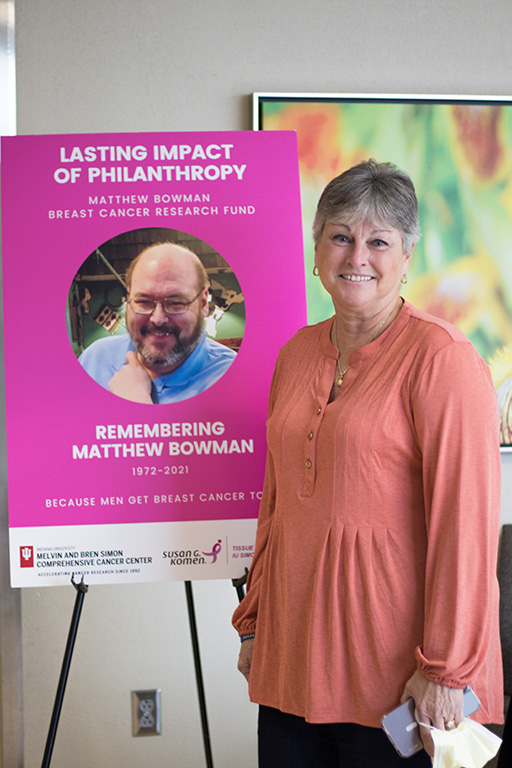Komen Tissue Bank is now collecting breast tissue from men
By Candace Gwaltney
May 17, 2023
A breast cancer diagnosis is difficult for anyone, but it can be particularly isolating for the thousands of men who face it each year. In the United States, about one in every 100 breast cancers diagnosed are in men and 500 men die of breast cancer yearly.
Researchers at the Indiana University Melvin and Bren Simon Comprehensive Cancer Center know that male breast cancer behaves and develops differently than that in women, and they are now working to discover more about the disease—thanks in part to Matthew Bowman.
The Vincennes, Ind., man became an advocate for male breast cancer awareness after his diagnosis in January 2017. The work came naturally to Bowman as he was already deeply involved in his southern Indiana community as a lieutenant for the Vincennes Township Volunteer Fire Department and nearly a 30-year employee at Good Samaritan Hospital in Vincennes, where he was a registered nurse.
When Bowman was diagnosed, he traveled to Indianapolis to see physician-scientist Bryan Schneider, M.D., for a second opinion. Schneider confirmed the treatment plan, so Bowman continued his care at his local cancer treatment center. The meeting led Bowman to enroll in a global study on male breast cancer at the IU Simon Comprehensive Cancer Center.
Once he thought he was cancer-free, Bowman was advocating for male breast cancer awareness at health fairs and on local television segments fulfilling his mission. Bowman relapsed in 2021 when a persistent cough turned out to be metastasized cancer to his lungs. He died from the disease at age 49 in September 2021.
With fewer cases, researchers and physicians don’t have the same data and resources to understand and treat male breast cancer. And treatments are often the same for men and women – despite their genetic differences. Few understand this impact like Bowman’s mother, Pat Buntrock, who is now carrying on his advocacy efforts for more research.
“I wanted to give money to IU specifically for men because there’s just not enough attention given to men with breast cancer,” Buntrock said. “Also, I wanted to give to IU because I knew that was the place to be for research in Indiana.”
A gift from Buntrock established the Matthew Bowman Breast Cancer Research Fund at the IU Simon Comprehensive Cancer Center. Through this fund, Bowman’s legacy will allow cancer center researchers to focus on understanding more about male breast cancer.
Additionally, a gift for male breast cancer research from the Heroes Foundation’s Catherine Peachey Fund, a longtime supporter of IU breast cancer research, is bolstering efforts for cancer center researchers to begin exploring the disease.
“The Catherine Peachey Fund has been touched by male breast cancer many times in our 28-year history. It is personal for us,” said Stephanie Rufenbarger Lesher, program manager of the Catherine Peachey Fund. “We continue to be grateful for the IU breast cancer researchers who push for new information and innovations. The specificity of research done with normal male breast tissue in the Komen Tissue Bank to address male breast cancer will hopefully lead to targeted treatments and therapies that will improve the outcomes for male breast cancer patients.”








